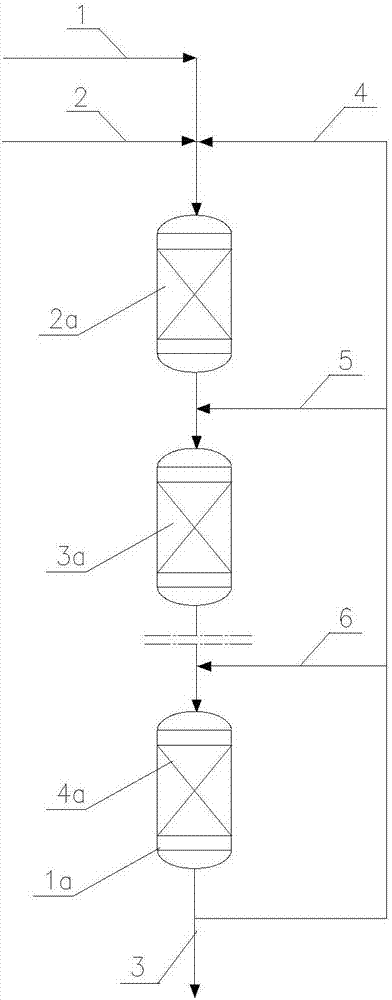Reaction method of ethylbenzene hydrogen peroxide and propylene to produce propylene oxide
A technology of ethylbenzene hydrogen peroxide and propylene oxide, which is applied in organic chemistry and other fields, can solve the problems of reaction temperature rise, achieve the effects of reducing reaction pressure, increasing the proportion of propylene, and controlling reaction temperature rise
- Summary
- Abstract
- Description
- Claims
- Application Information
AI Technical Summary
Problems solved by technology
Method used
Image
Examples
Embodiment 1
[0035] according to figure 1 The technical scheme shown, raw material contains the hydrogen peroxide ethylbenzene mixture of 19.4% weight concentration, and flow rate is 162367.5 kg / hour, raw material propylene 10987.6 kg / hour and circulating propylene 155795.5 kg / hour, enters two series multi-bed catalysts In an adiabatic fixed bed reactor, under the conditions of reaction temperature 76°C and reaction pressure 2.9MPaG, Ti / SiO 2 Catalyst contact, liquid phase epoxidation reaction to generate propylene oxide, methyl benzyl alcohol and other by-products; the reactants flowing out of the first reactor are mixed with the recycle stream entering the second reactor, the temperature is controlled at 76 °C, and enter the second reactor The reactor is in contact with Ti / SiO2 catalyst, and the liquid phase epoxidation reaction generates propylene oxide, methyl benzyl alcohol and other by-products. Ethyl Hydroperoxide Gravity Space Velocity 4.1 hr -1 , the mol ratio of total propylene...
Embodiment 2
[0037] Same as [Example 1], only change the flow rate of circulating propylene: the flow rate of circulating propylene is 103863.5 kg / hour, and others are the same as [Example 1]. Hydrogen peroxide ethylbenzene weight space velocity 4.1hr -1 , the mol ratio of total propylene and ethylbenzene hydrogen peroxide is 11.5, the mol ratio of the propylene of the first reactor and the second reactor inlet and ethylbenzene hydrogen peroxide then reaches 11.5 and 23.2, the first reactor and the second The outlet temperatures of the reactors were 88.8°C and 88.6°C respectively, the total conversion rate of ethylbenzene hydroperoxide was 99.2%, and the molar selectivity of propylene oxide was 99.0%.
Embodiment 3
[0039] Same as [Example 1], only the reactor form is changed: two adiabatic fixed-bed reactors with a single-bed catalyst are connected in series, and the others are the same as [Example 1]. Ethyl Hydroperoxide Gravity Space Velocity 4.1 hr -1 , the mol ratio of total propylene and ethylbenzene hydroperoxide is 16.75, the mol ratio of the propylene of the first reactor and the second reactor inlet and ethylbenzene hydrogen peroxide then reaches 16.75 and 34.12, the first reactor and the second The outlet temperatures of the reactors were 87.1°C and 86.8°C respectively, the total conversion rate of ethylbenzene hydroperoxide was 99.2%, and the molar selectivity of propylene oxide was 99.1.
PUM
 Login to View More
Login to View More Abstract
Description
Claims
Application Information
 Login to View More
Login to View More - R&D
- Intellectual Property
- Life Sciences
- Materials
- Tech Scout
- Unparalleled Data Quality
- Higher Quality Content
- 60% Fewer Hallucinations
Browse by: Latest US Patents, China's latest patents, Technical Efficacy Thesaurus, Application Domain, Technology Topic, Popular Technical Reports.
© 2025 PatSnap. All rights reserved.Legal|Privacy policy|Modern Slavery Act Transparency Statement|Sitemap|About US| Contact US: help@patsnap.com

